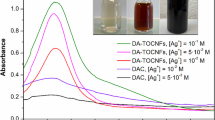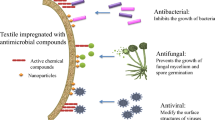Abstract
Encapsulation of various materials on textiles is an interesting task because of the controlled release and higher stability. Here, a robust cotton fabric was prepared through novel simultaneous treatment and nano-encapsulation of Chamomile extract using Tragacanth gum (TG) as the wall material and an environmentally friendly binder with hydrogel properties. The nano-encapsulated and treated cotton (NE&TC) fabric was characterized by FESEM, FT-IR and UV-Vis spectrophotometry, which indicated the successful encapsulation of the plant extract within the TG and material and linkage on the cotton fabric. The peaks at 1736 and 1777 cm−1 related to the TG and Chamomile extract in the FT-IR spectrum and a strong peak around 270–400 nm in the UV-Vis spectrum of the NE&TC fabric confirmed the nano-encapsulation and treatment. The prepared NE&TC fabric indicated a relatively good washing and rubbing durability with reasonable release behavior. The DSC pattern of the NE&TC fabric showed a peak at 162 °C confirming the presence of Chamomile extract in the nanocapsules. This article proposes a novel method for the application of TG as a natural polymer on cotton fabric for obtaining multifunction purposes including in-situ synthesis of encapsulated Chamomile extract, stabilization of nanocapsules and introduction of hydrogel properties.







Similar content being viewed by others
References
AATCC Test Method 79-2014, Absorbency of textiles. American Association of Textile Chemists and Colorists, Research Triangle Park, NC, USA
Ahmed EM (2015) Hydrogel: preparation, characterization, and applications: a review. J Adv Res 6:105–121. doi:10.1016/j.jare.2013.07.006
ASTM D-1388-64 (1975) Method A: standard test method for stiffness of fabrics. ASTM, New York
ASTM D2402–07 (2012) Standard test method for water retention of textile fibers (centrifuge procedure). ASTM International, West Conshohocken
Chen S, Chen S, Jiang S, Xiong M, Luo J, Tang J, Ge Z (2011a) Environmentally friendly antibacterial cotton textiles finished with siloxane sulfopropylbetaine. ACS Appl Mater Interfaces 3:1154–1162. doi:10.1021/am101275d
Chen X, Yu J, Zhang Z, Lu C (2011b) Study on structure and thermal stability properties of cellulose fibers from rice straw. Carbohydr Polym 85:245–250. doi:10.1016/j.carbpol.2011.02.022
Dastjerdi R, Montazer M (2010) A review on the application of inorganic nano-structured materials in the modification of textiles: focus on anti-microbial properties. Colloids Surf B 79:5–18. doi:10.1016/j.colsurfb.2010.03.029
Dong X, Zhu Q, Dai Y, He J, Pan H, Chen J, Zheng Z-P (2016) Encapsulation artocarpanone and ascorbic acid in O/W microemulsions: preparation, characterization, and antibrowning effects in apple juice. Food Chem 192:1033–1040
El-Shishtawy RM, Asiri AM, Abdelwahed NAM, Al-Otaibi MM (2011) In situ production of silver nanoparticle on cotton fabric and its antimicrobial evaluation. Cellulose 18:75–82
Ghayempour S, Mortazavi SM (2013) Fabrication of micro–nanocapsules by a new electrospraying method using coaxial jets and examination of effective parameters on their production. J Electrostat 71:717–727. doi:10.1016/j.elstat.2013.04.001
Ghayempour S, Mortazavi SM (2014) Antibacterial activity of peppermint fragrance micro–nanocapsules prepared with a new electrospraying method. J Essent Oil Res 26:492–498. doi:10.1080/10412905.2014.949882
Ghayempour S, Mortazavi SM (2015a) Microwave curing for applying polymeric nanocapsules containing essential oils on cotton fabric to produce antimicrobial and fragrant textiles. Cellulose 22:4065–4075. doi:10.1007/s10570-015-0765-1
Ghayempour S, Mortazavi SM (2015b) Preparation and investigation of sodium alginate nanocapsules by different microemulsification devices. J Appl Polym Sci. doi:10.1002/app.41904
Ghayempour S, Montazer M, Mahmoudi Rad M (2015) Tragacanth gum as a natural polymeric wall for producing antimicrobial nanocapsules loaded with plant extract. Int J Biol Macromol 81:514–520. doi:10.1016/j.ijbiomac.2015.08.041
Ghayempour S, Montazer M, Mahmoudi Rad M (2016) Tragacanth gum biopolymer as reducing and stabilizing agent in biosonosynthesis of urchin-like ZnO nanorod arrays: a low cytotoxic photocatalyst with antibacterial and antifungal properties. Carbohydr Polym 136:232–241. doi:10.1016/j.carbpol.2015.09.001
Ghosh SK (2006) Functional coatings and microencapsulation: a general perspective. In: Functional coatings. Wiley-VCH Verlag GmbH & Co. KGaA, pp 1–28. doi:10.1002/3527608478.ch1
Gupta S (2011) Biocompatible microemulsion systems for drug encapsulation and delivery. Curr Sci 101:174–188
International Standard, ISO 105-C10 (2006) Textiles-tests for colour fastness: colour fastness to washing with soap or soap and soda. International Organization for Standardization (ISO), Switzerland
International Standard, ISO 105-X12 (2001) Textiles-tests for colour fastness: colour fastness to rubbing. International Organization for Standardization (ISO), Switzerland
Kang Z-Z, Zhang B, Jiao Y-C, Xu Y-H, He Q-Z, Liang J (2013) High-efficacy antimicrobial cellulose grafted by a novel quaternarized N-halamine. Cellulose 20:885–893
Kristensen JB, Meyer RL, Poulsen CH, Kragh KM, Besenbacher F, Laursen BS (2010) Biomimetic silica encapsulation of enzymes for replacement of biocides in antifouling coatings. Green Chem 12:387–394. doi:10.1039/B913772F
Kumar A, Kulkarni P, Samui AB (2014) Polyethylene glycol grafted cotton as phase change polymer. Cellulose 21:685–696. doi:10.1007/s10570-013-0120-3
Li S, Boyter H, Qian L (2005) UV curing for encapsulated aroma finish on cotton. The Journal of The Textile Institute 96:407–411. doi:10.1533/joti.2005.0116
Li Z et al (2015) Sonochemical synthesis of hydrophilic drug loaded multifunctional bovine serum albumin nanocapsules. ACS Applied Materials & Interfaces 7:19390–19397. doi:10.1021/acsami.5b05558
Liu Y, Liu Y, Ren X, Huang TS (2014) Antimicrobial cotton containing N-halamine and quaternary ammonium groups by grafting copolymerization. Appl Surf Sci 296:231–236. doi:10.1016/j.apsusc.2014.01.106
Manna J, Goswami S, Shilpa N, Sahu N, Rana RK (2015) Biomimetic method to assemble nanostructured Ag@ZnO on cotton fabrics: application as self-cleaning flexible materials with visible-light photocatalysis and antibacterial activities. ACS Appl Mater Interfaces 7:8076–8082. doi:10.1021/acsami.5b00633
McKay DL, Blumberg JB (2006) A review of the bioactivity and potential health benefits of peppermint tea (Mentha piperita L.). Phytother Res 20:619–633. doi:10.1002/ptr.1936
Mondal S (2008) Phase change materials for smart textiles—an overview. Appl Therm Eng 28:1536–1550
Montazer M, Kahali P (2016) A novel polyvinyl alcohol–tragacanth/nano silver hydrogel on polyester fabric through in situ synthesis method. J Ind Text 45:1635–1651
Murillo-Cremaes N, Lopez-Periago AM, Saurina J, Roig A, Domingo C (2010) A clean and effective supercritical carbon dioxide method for the host-guest synthesis and encapsulation of photoactive molecules in nanoporous matrices. Green Chem 12:2196–2204. doi:10.1039/C004762G
Roby MHH, Sarhan MA, Selim KA-H, Khalel KI (2013) Antioxidant and antimicrobial activities of essential oil and extracts of fennel (Foeniculum vulgare L.) and chamomile (Matricaria chamomilla L.). Ind Crops Prod 44:437–445. doi:10.1016/j.indcrop.2012.10.012
Rodrigues SN, Martins IM, Fernandes IP, Gomes PB, Mata VG, Barreiro MF, Rodrigues AE (2009) Scentfashion®: microencapsulated perfumes for textile application. Chem Eng J 149:463–472
Sánchez P, Sánchez-Fernandez MV, Romero A, Rodríguez JF, Sánchez-Silva L (2010) Development of thermo-regulating textiles using paraffin wax microcapsules. Thermochim Acta 498:16–21
Shen Y, Zhen L, Huang D, Xue J (2014) Improving anti-UV performances of cotton fabrics via graft modification using a reactive UV-absorber. Cellulose 21:3745–3754. doi:10.1007/s10570-014-0367-3
SIST-EN 12127 (1999) Determination of mass per unit area using small samples. CEN, Brussels
SIST-EN ISO 5084:1999 (1996) Determination of thickness of textiles and textile products. CEN, Brussels
Solomon B, Sahle FF, Gebre-Mariam T, Asres K, Neubert RHH (2012) Microencapsulation of citronella oil for mosquito-repellent application: formulation and in vitro permeation studies. Eur J Pharm Biopharm 80:61–66
Yu W, Lin J, Liu X, Xie H, Zhao W, Ma X (2010) Quantitative characterization of membrane formation process of alginate–chitosan microcapsules by GPC. J Membr Sci 346:296–301
Zhang L et al (2011) Bioinspired preparation of polydopamine microcapsule for multienzyme system construction. Green Chem 13:300–306. doi:10.1039/C0GC00432D
Author information
Authors and Affiliations
Corresponding author
Rights and permissions
About this article
Cite this article
Ghayempour, S., Montazer, M. A robust friendly nano-encapsulated plant extract in hydrogel Tragacanth gum on cotton fabric through one single step in-situ synthesis and fabrication. Cellulose 23, 2561–2572 (2016). https://doi.org/10.1007/s10570-016-0958-2
Received:
Accepted:
Published:
Issue Date:
DOI: https://doi.org/10.1007/s10570-016-0958-2




